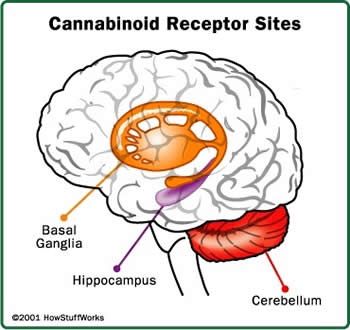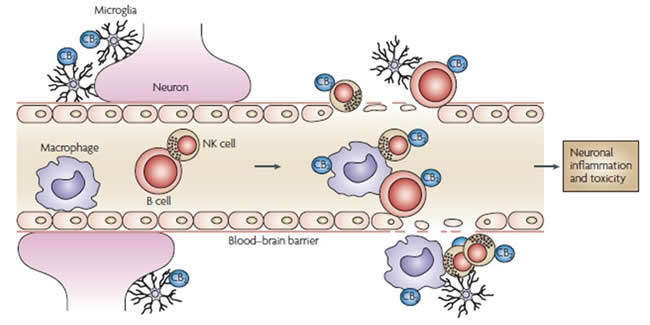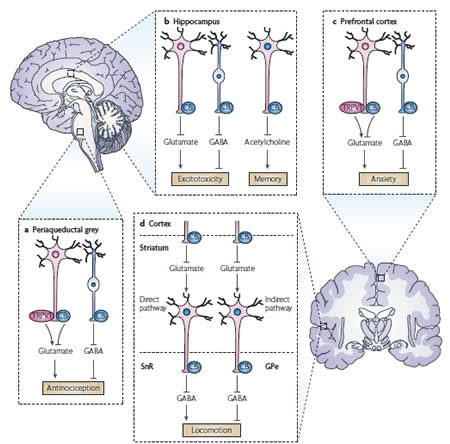Positive Health Online
Your Country

The Endocannabinoid System (ECS) and Its Deficiencies: the New Science of Homeostasis
by Stephen McCamman(more info)
listed in medical cannabis, originally published in issue 237 - April 2017
Introduction
Most blockbuster scientific discoveries do not start with transporting 10 kilos of an illicit substance on public transport. The exception is Israeli biochemist Raphael Mechoulam's short and aromatic 1964 bus trip from the local police station to his laboratory at Jerusalem's Weizmann Institute with over $100,000 worth of concentrated cannabis, or hashish. His team's subsequent research into the physiological effects of Cannabis L. Sativa on Rhesus monkeys, as well as some informal experimentation on his friends and colleagues, ultimately led to the cloning of the CB1 receptor in 1990 and CB2 in 1992. This discovery completed the mapping of the ‘classic’ Endocannabinoid (ECS) system, a scientific breakthrough that is similar in magnitude to the discovery of antibodies in the twentieth century.

http://science.howstuffworks.com/marijuana3.htm
Kevin Bonsor & Nicholas Gerbis "How Marijuana Works" 2 July 2001.
HowStuffWorks.com. <http://science.howstuffworks.com/marijuana.htm> 23 February 2017.
The purpose of this article is to trigger a deeper conversation about the ECS system and Clinical Endocannabinoid Deficiency Syndrome (CECDS), in clinical settings by addressing the following:
- An overview of the general structure and function of the ECS system;
- A discussion of Dr Ethan Russo's Clinical Endocannabinoid Deficiency Syndrome that posits that a nutritional deficiency of the ECS system may be the cause of a number of treatment resistant diseases;
- Suggest a tentative framework that will help clinicians identify both the causes and symptoms of CECDS, while pointing them toward the tools of diagnosis and various treatments.
The article closes with a discussion of the various cultural, institutional, and legal barriers, primarily around the plant Cannabis L Sativa, that have contributed to an inaccurate conception of the interplay between cannabis and the ECS system, thwarting both research and clinical applications of this new discovery.
Overview of the Endocannabinoid System
The ECS system is a unique biochemical signalling network of lipid ligands, receptors, and enzymes present in all vertebrate from the sea squirt to humans. The ECS system performs a variety of essential homeostatic functions across a broad spectrum of biological processes related to "relaxing, eating, sleeping, forgetting, and protecting."[1] However, as detailed below, DiMarzo's description fails to grasp the full extent of the functions of the ECS system throughout the entire body.
The ‘Classic’ ECS system consists of lipid ligands, called endocannabinoids, cell receptors, CB1 and CB2, and metabolic enzymes, fatty acid amide hydrolase (FAAH) and monoacylglycerol lipase (MGA). Researchers suggest that GPR55, possibly a CB3 receptor and potential vanilloid (TRPV11) are also involved in the ECS system; the identification of the precise interaction remains unidentified.[2] A number of other endogenous compounds have been identified as possible endocannabinoids but have not yet been included in the traditional definition, which raises the key point that the entire scope and functions of the ECS system have yet to be determined.
The two traditional endocannabinoids - often called "the body’s own marijuana" due to phytocannabinoids affinity for the same receptors - are anandamide (N-arachidonoylethanolamine or AEA) and named after the Sanskrit word for ‘bliss’ and 2-arachidonoylglycerol (2-AG). Produced on demand from fatty acid lipid precursors, AEA is found in both the central and peripheral nervous systems and binds to the CB-1 receptor, the most prevalent g-protein coupled receptor in the brain.[3]
Ongoing research explores the role anandamide has in the following areas:
- Eating;
- Sleep patterns;
- Pain;
- Embryonic implantation in the uterus;
- Motivation and pleasure.
AEA is primarily responsible for our sense of well-being as well as associated with the ‘runner's high’ - previously ascribed to the release of endorphins. In addition, AEA acts as a retrograde neurotransmitter, blocking the downstream transmission of GABA and Glutamate.[4] 2-AG, the most prevalent endocannabinoids, also binds to the CB-1 receptor, and is found primarily in the central nervous system. Found in both bovine and human breast milk, 2-AG is thought to be responsible for induction of the suckling of infants and plays a role in appetite regulation and immune system functions.
At this point, the reader can be somewhat overwhelmed by the complex role the ECS system plays in the body. Perhaps it is best to leave it at the insight that "...there is hardly any physiological process that is not affected by the (ECS System) to some degree".[5] It may turn out that even this is an understatement, as it appears that the ECS is ultimately responsible for keeping all of the fundamental processes of everyday life in balance, including psycho-social processes such as our sense of self and our relationship to the world - both psychologically and spiritually.[6] Metaphorically then, proper regulation of the ECS system may be in fact the primary mechanism that balances mind and body. Numerous phytocannabinoids, primarily from the plant Cannabis L. Sativa, bind to CB1 and CB2 receptors. Tetrahydrocannabinol (THC) and Cannabidiol are the most common phytocannabinoids. Research is ongoing on the effects of CBG, CBN, and THCa. Scientists suggest that the essential oils found in many plants also act in an entourage effect, facilitating the uptake of the phytocannabinoids. Lastly, Beta-caryophyllene has been found to bind to CB2, suggesting that it is also a phytocannabinoid.
While the interplay between the ECS system and phytocannabinoids is outside the scope of this introductory article, it is worth noting that researchers are looking into the relationship between a wide variety of diseases and the role of phytocannabinoids, such as tetrahydrocannabinol. Each one plays a role in regulating the ECS system. Limited by a naive approach to dosing and limited access to cannabinoids, robust clinical research is in its infant stages. Below is just a short list of the diseases and conditions researchers are only now beginning to examine.

Neuronal Inflammation and Toxicity
List Of Diseases[13]
- Neuropathic pain;
- Movement Disorders (Huntington's and Parkinson's);
- Dementia (Alzheimer's);
- Chronic Pain; Migraines;
- Mood Disorders, such as depression and anxiety;
- Sleep Disorders; Epilepsy;
- Auto-immune diseases; Multiple Sclerosis;
- Palliative Care for Chemotherapy;
- Treatment of some forms of Cancer (notably breast cancer);
- Autism;
- Arthritis; Osteoporosis
- Irritable Bowel Syndrome;
- Fibromyalgia;
- Spinal Cord Injury;
- Stroke; Myocardial infarction; Hypertension; Glaucoma;
- Metabolic syndromes;
- Diabetes.
Overview of Clinical Endocannabinoid Deficiency Syndrome
Clinical Endocannabinoid Deficiency Syndrome is the aetiology of a complex array of physical and mental conditions, typically (mis-diagnosed as discrete diseases, such as migraines, irritable bowel syndrome, and fibromyalgia.[7] . A broader spectrum of chronic pain disorders, autoimmune disorders, gastrointestinal issues, as well as mood disorders, such as anxiety and depression, may also have their pathophysiological origins in a deficient ECS system. As Russo states “clinical endocannabinoid deficiency (CECD), whether congenital or acquired may help to explain the pathophysiology of certain diagnostic pitfalls, especially those characterized by hyperalgesia, and thereby provide a basis for their treatment with cannabinoid medicines.”[8]
Russo has suggested that the migraines are interrelated to ECS functioning. “AEA has to potentiate and to inhibit properties at receptors involved in migraines. Also, Cannabinoids also demonstrate dopamine-blocking and anti-inflammatory effects. AEA is tonically active in the periaqueductal gray matter, a migraine generator. THC modulates glutamatergic neurotransmission via NMDA receptors."[9] Moreover, cannabinoids have been shown to block various mechanisms related to the co-morbid diseases of IBS, fibromyalgia, and migraines. The efficacy of cannabis in alleviating the symptoms of these three diseases, suggests that properly toning the ECS system can clinically resolve such issues.
Not surprisingly, the inability of clinicians to identify the etiology of these conditions - a deficient endocannabinoid system - causes a chain of clinical events that limit the overall efficacy of conventional treatment protocols.

Complex Array of ECS Component Functions
A Preliminary Diagnostic and Treatment Tool for CECDS
This section puts forth a model for clinicians to identify and treat CECDS within the context of their country's laws. Non-cannabis treatments, such as nutritional changes, environmental recommendations, complementary care and lifestyle adjustments should be in the first line of clinical treatment. Given the ongoing research into the ECS system and CECDS, this is by no means a definitive tool; rather, it is a starting point to codify the vast amount of research into a tool useful for clinicians.
- The CECDS is accompanied by co-morbid symptoms such as sleep disorders, cognitive problems, fatigue, gastrointestinal distress, mood disorders, and neurological dysfunction;
- Barring any clear counter indication, clinicians should group seemingly disparate diagnosis that presents along the digestive, neurological, emotional, and immune function axis under ECS Syndrome. In other words, the aetiology of a presenting cluster of treatment resistance, and therefore, mistreated disease states may be a function of ECS Syndrome;[10]
- Assays are in development stages, so no tests as of yet are available at the clinical level.
Symptoms
- Co-morbid disease states should be the primary cluster of ‘symptoms’ of ECS Syndrome; yet a variety of other identifiable symptoms are common in ECS Syndrome patients. Symptoms include: moderate to severe fatigue, sleep disorders, problems with cognitive functioning, IBS, headaches and migraines, mood disorders not limited to anxiety and depression, environmental sensitivities, auto-immune disorders, chronic pain states, metabolism issues, and inflammation. Also, an inability to process pain, or a failure of traditional pain management protocols, along with an amplified response to sensory or emotional stimuli may also be cause for a diagnosis of ECS Syndrome. A deficient ECS may trigger developmental disabilities in children and even some cancers, but the research is tentative;[11]
- Some people may have only 1-2 symptoms while others may have many. Symptoms may often come and go and many people may have trouble identifying, and thus articulating to the attending physician, the co-morbid nature of their disease(s). Systemic and prolonged deprivation of the ECS, which is fundamental to the proper functioning of almost all physiological processes in the body, may be a diagnostic black box for both patient and physician, thus, hindering the mutual task of accurately diagnosing the cause of the patient's condition;
- Obesity indicates an over active endocannabinoid system, but a causal relationship has yet to be established.
Causes
- The ECS system can be deficient in several ways: an insufficient amount of enzymes and fatty acid precursors, an inability of the endocannabinoid ligands to bind to the receptor site, a limited or ineffective number of G-protein coupled receptors to uptake the ligands, and, finally, dysfunction in the enzymatic degradation of the endocannabinoids;
- Recent research has suggested that a deficiency of nutrients, both fatty acid precursors and a chronic deprivation of phytocannabinoids, cannabimimetic flavonoids, and/ or essential oils may also inhibit the proper function of the ECS system;
- Environmental toxins, pesticides, insecticides, and plasticizers may also inhibit the proper functioning of the endocannabinoid system. As McPartland writes “Pesticides such as chlorpyrifos and diazinon alter normal ECS system function Piperonyl butoxide, which is a synergist added to insecticides such as pyrethrum, is an efficacious but low-potency antagonist of CB1…Phthalates are plasticizers added to water bottles, tin cans, food packaging, and even the enteric coating of pharmaceutical pills. Phthalates may act as endocrine disruptors and carcinogens; They also block CB1 - as allosteric antagonists ”[12]
- ECS Syndrome may emerge following sustained unhealthy lifestyle habits, including disrupted sleep, chronic and acute stress states, both physical and mental, and chronic alcohol and drug abuse may act as a cumulative ‘trigger’ in the development of presenting symptoms. These chronic, sustained stressors on the body and mind suggest that ECS Syndrome may appear more frequently in middle-aged or older people as it may take the body years to develop the symptoms of the endocannabinoid system inhibitory factors.
Treatments
- Changes in diet and lifestyle, including exercising and detoxifying both the body and the environment, are the first line of treatment, though this may be hard given the condition of the patient, physically, emotionally, and financially;
- A regime of cannabinoid therapy may also be necessary depending on the severity of the deficiency. Low doses of cannabidiol are a safe baseline from which to start treatment. Depending on the patient's legal and cultural constraints, low dose mucosal delivery of a whole plant cannabis extract is another baseline protocol. Each person’s metabolism of cannabinoids is unique, so starting on a low dose and accurately titrating is fundamental to the development of a successful treatment protocol. Experimentation with dosage, cannabinoid, and terpene combinations, and method of administration may be necessary;
- If deemed necessary, pharmacological treatments should focus on the so-called individualized diseases (It is important to note that migration of off-pharmaceutical drugs is one of the treatment benefits of cannabinoid therapeutics). Sativex, a whole plant cannabis extract designed for epilepsy, completed Stage 3 trials and may be used off-label to treat ECS Syndrome when it comes to market. Other Investigational New Drug (IND) orphan applications are making their way through the drug approval process (Note: a large number of prescription pills contain phthalate, which has been shown to block CB1 uptake in mice). The clinician should identify the number of medications prescribed that contain the phthalate esters and determine the risk/benefit of continuing treatment;
- Non-pharmacological therapies such as aerobic exercise, meditation, and various talk therapies have demonstrated benefits of alleviating ECS Syndrome and migrating the patient toward wellness;
- Complementary therapies, such as massage with cannabinoid infused oil if possible, myofascial release, acupuncture, chiropractic, and yoga, and spiritual practices may also be effective tools in properly toning the ECS system;
- Increasing relaxation and quality sleep, pacing activities, and reducing stress, can help minimize symptoms, improve ECS toning, and enhance the quality of life.[12]
Discussion
Frequently, the response of researchers and clinicians at this point is one of disbelief and suspicion about the expansive role the ECS system plays in balancing and healing the human body. Coupled with the legal and cultural taboos around cannabis, this cultural and institutional resistance impedes research, clinical trials, and, most importantly, patients’ access to what amounts to an herbal remedy.
The information above is designed to create a framework for understanding the role of the ECS system and cannabis play in homeostasis. Hopefully, it can then open the discussion among clinicians on the science, and the clinical applications of what can be termed ‘cannabinoid therapeutics’ can emerge from the propaganda surrounding the cannabis plant and the institutional bias toward new discoveries and find its legitimate place: in the realm of science and medicine.
We still don't know the full scope of the ECS system in our body and the healing properties, let alone the efficacy of phytocannabinoids to heal, yet, this limitation resides in those above mentioned cultural, institutional, and cognitive bias that constrain the robust discussion this topic deserves.
These challenges, and many others, have thus resulted in a relative paucity of basic research, clinical trials, and consistent dosing guidelines, not to mention a limited supply of cannabinoid-based remedies available to patients around the world. We still don't know the real scope of the ECS system in our body and the healing properties. Moreover, our understanding of the role cannabis plays in toning the ECS system is at the beginning stages. This limitation resides in the cultural, institutional, and cognitive bias rather than a thorough vetting of the science itself.
The intent of this and forthcoming articles, then, is to contribute to a scientific and clinical paradigm shift and the importance of the ECS system to both mind and body, and their interrelationship, in other words, optimum wellness, as well as embracing the healing power of phytocannabinoids throughout the health and wellness community.[14]
References and Notes
1. DiMarzo. Endocannabinoids and other fatty acid derivatives with cannabimimetic properties: biochemistry and possible physiopathological relevance. Biochimica et Biophysica Acta - Lipids and Lipid Metabolism 1392: 153・175. 1998.
2. McPartland, et al. Care and Feeding of the Endocannabinoid System: A Systematic Review of Potential Clinical Interventions that Upregulate the Endocannabinoid System. PLoS One. 9(3): e89566.2014. doi: 10.1371/journal.pone.0089566. March 12 2014.
3. Mechoulam R and Hanu L.: The cannabinoid system: from the point of view of a chemist. Marihuana and Madness. Psychiatry and Neurobiology. (edited by David Castle and Robin Murray), Cambridge University Press 2004, book chapter, pp 1-18 Data • Dec 2013.
4. Ibid
5. Russo, E.B.Neuro Endocrinol Lett. 29(2):192-200. Clinical endocannabinoid deficiency (CECD): can this concept explain therapeutic benefits of cannabis in migraine, fibromyalgia, irritable bowel syndrome and other treatment-resistant conditions? Apr 2008.
6. Mechoulam R. and Hanu L. The cannabinoid system: from the point of view of a chemist. Marihuana and Madness. Psychiatry and Neurobiology. (edited by David Castle and Robin Murray), Cambridge University Press 2004, book chapter, pp 1-18 Data • Dec 2013.
7. Russo, EB. Neuro Endocrinol Lett. 29(2):192-200.Clinical endocannabinoid deficiency (CECD): can this concept explain therapeutic benefits of cannabis in migraine, fibromyalgia, irritable bowel syndrome and other treatment-resistant conditions? Apr 2008.
8. Ibid
9. Ibid
10. Ibid
11. Neuro Endocrinol Lett. 35(3):198-201.Clinical endocannabinoid deficiency (CECD) revisited: can this concept explain the therapeutic benefits of cannabis in migraine, fibromyalgia, irritable bowel syndrome and other treatment-resistant conditions? Smith SC, Wagner MS. 2014.
12. McPartland, et al Care and Feeding of the Endocannabinoid System: A Systematic Review of Potential Clinical Interventions that Upregulate the Endocannabinoid System. PLoS One. 9(3): e89566.2014. doi: 10.1371/journal.pone.0089566. March 12 2014.
13. www.medicalcannabisclinic.com.au/medicinal-cannabis/clinical-studies-references
14. Patients suffering from epilepsy, cancer, and other serious diseases in the United States, for example, are moving their entire families to states such as Colorado and California to gain legal access to the medicinal products available in these states)
Comments:
-
No Article Comments available